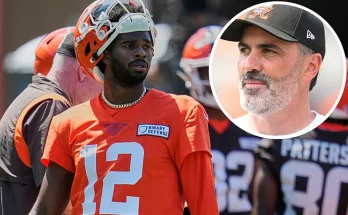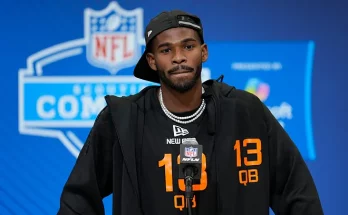Duke basketball, a program synonymous with excellence, tradition, and championship expectations, is facing an unfamiliar situation heading into the 2025-26 college basketball season. For the first time in recent memory, the Blue Devils find themselves ranked outside the top five in a prominent set of preseason rankings. An expert projection from one of the sport’s most respected analysts has Duke slotted at No. 7, sparking debate across the college basketball landscape.
The ranking marks a significant deviation from the usual high praise bestowed upon a program that has long lived near the summit of the sport. Under head coach Jon Scheyer, who took over the reins from legendary Mike Krzyzewski in 2022, the Blue Devils have remained nationally relevant, made deep tournament runs, and continued to bring in top-tier talent. But despite another strong recruiting class and the return of several key contributors, the team’s placement just outside the top five has prompted a mix of concern, skepticism, and motivation for a fanbase and locker room used to being near or at the top.
So why the drop?
Much of the rationale behind the expert’s ranking stems from lingering questions about roster cohesion, star power, and depth. While Duke returns All-American Cooper Flagg, who stunned the basketball world by turning down massive NIL offers from other powerhouse programs to stay in Durham, the overall makeup of the team raises some eyebrows. Flagg, who captured the Wooden Award as a freshman, is widely viewed as the best player in college basketball. But the departure of experienced veterans and uncertainty around the supporting cast has led some to question whether this iteration of the Blue Devils can match the dominance of past squads.
Gone are names like Jeremy Roach, who provided steady leadership at the point, and Mark Mitchell, a versatile forward who anchored Duke’s defense. The Blue Devils will also be without center Kyle Filipowski, who opted to declare for the NBA Draft after a productive sophomore season. Their exits leave a void in both production and leadership—qualities that can’t always be easily replaced by five-star freshmen, no matter how talented.
Still, Duke doesn’t lack talent. The incoming class is once again stacked, headlined by top-10 recruits who are expected to contribute immediately. However, critics of the ranking argue that relying heavily on freshmen, even those as gifted as Duke’s, is a risky proposition in today’s increasingly veteran-laden college game. Programs like Kansas, UConn, and Houston have shown the value of experienced, physically mature rosters. In contrast, Duke’s youth movement, while promising, carries inherent volatility.
Adding to the scrutiny is the pressure on Jon Scheyer himself. Though he has proven himself as a capable recruiter and game-planner, questions remain about his ability to guide a young team through the grind of an ACC schedule and the intensity of March Madness. Last season’s Sweet 16 exit, while respectable, fell short of the sky-high expectations in Durham. And with each season removed from Coach K’s tenure, the microscope on Scheyer only intensifies.
Some around the program view the drop in ranking as a slight, perhaps even a motivational tool. Players and coaches have already begun to embrace the “underdog” narrative—a curious position for a school that is arguably the face of college basketball. But make no mistake: this is still Duke. And being ranked seventh in the country, while lower than usual, still positions the Blue Devils as a national contender.
One major bright spot remains Cooper Flagg. The 6-foot-9 sophomore is not just a college basketball superstar; he is a cultural phenomenon. From his highlight-reel dunks to his cerebral defensive play, Flagg impacts every aspect of the game. More importantly, he’s shown a maturity beyond his years, acting as a de facto leader even as a freshman. His decision to stay for a second year was met with widespread praise and further solidified his commitment to building something lasting at Duke. With Flagg in the fold, the Blue Devils have a foundation few teams can match.
Beyond Flagg, other returning players offer hope. Caleb Foster is expected to take on a larger role in the backcourt, showcasing the scoring and playmaking abilities that made him a five-star recruit. Sean Stewart, who flashed brilliance in limited minutes last season, will be asked to take on more responsibility in the frontcourt. Jaylen Blakes, one of the few upperclassmen on the roster, could emerge as a vocal leader and stabilizing force. Their growth and chemistry will be crucial as the Blue Devils attempt to coalesce into a true championship contender.
Then there’s the freshman class. Once again, Duke has landed several blue-chip recruits, including dynamic point guard Malachi Palmer and versatile wing Karter Knox. Both are expected to compete for starting roles and bring a mix of athleticism, skill, and competitiveness. But as with all freshmen, there will be a learning curve. How quickly they can adapt to the college game—and how well they gel with returning players—could determine the trajectory of Duke’s season.
In today’s college basketball environment, rankings often reflect not just raw talent but experience, continuity, and depth. That’s where some of Duke’s competitors may have an edge. Programs like Purdue and Baylor bring back core pieces with NCAA Tournament mileage. North Carolina, always a rival and often a benchmark, returns a seasoned roster that is already generating Final Four buzz. Even programs like Michigan State and Arizona, both known for their physicality and defense-first mindset, are ranked higher in some preseason projections due to their veteran presence and system familiarity.
Yet if history has taught us anything, it’s that preseason rankings are far from predictive. Just last season, several top-10 teams failed to make it past the first weekend of the NCAA Tournament, while a handful of lower-ranked squads made Cinderella runs to the Elite Eight and Final Four. For Duke, being ranked seventh might just offer the perfect blend of respect and challenge. It removes the suffocating pressure of being No. 1 while still acknowledging the team’s immense potential.
Internally, the message is clear: let the doubters talk. Duke thrives when the stakes are highest. The players and coaches know that rankings in April matter far more than those in October. And with a full offseason to build chemistry, install schemes, and define roles, the Blue Devils believe they’ll be peaking when it matters most.
Recruiting success, elite facilities, and a legacy of excellence mean that Duke will always be in the national conversation. But the 2025-26 season represents a new kind of challenge—one where talent alone won’t be enough. The Blue Devils must now prove that they can win not just with flashy names and high expectations, but with grit, growth, and unity. They must defend with intensity, rebound with purpose, and play with the selflessness that defines championship teams.
The journey back to the top five—and potentially beyond—starts with embracing the grind. It starts with player development, with leadership emerging not just from Flagg but from every corner of the locker room. It starts with accountability, consistency, and a hunger to silence the critics.
If there’s one thing that can never be counted out, it’s the pride of Duke basketball. And while being ranked outside the top five might sting for a moment, it could be the very spark this team needs. Because when the lights are brightest and the games mean the most, few programs deliver like Duke. The countdown to tip-off has already begun. And for a Blue Devil squad with something to prove, the time to rise is now.



